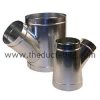Ok I will explain , first and most, you will need plenty of fresh air in a basement grow , if your house is old meaning it does not have air vents built In the foundation ,you must get fresh air moving through your basement, because you are below the frost line and radon gases seep through your walls and floor . and being you are in the north east radon levels can be high,
not saying you have high level, but you have to understand that radon has a high attraction for soil and it is very harmful to you. your plants will feed on the radon through the soil.
I know it is never discussed here maybe guys here don't know are understand how harmful radon is , all the earth emits radon ,you can have the levels tested in you home by a home inspection company , but in my opinion and building experience you want to move lots of fresh air through your basement if you are growing in your basement in soil.
Now lets move on to your questions yes you wll use a 8'' to 6'' reducer fitting off the tee on the exhaust side of the fan (transition) and include a manual damper on the 6'' outside air fan intake side, this will allow you to :
A) buy using a damper in the 6'' duct going to the outside the damper itself will act like a speed controller letting you manipulate the amount of air you exhaust inside your grow area.
this I called a bypass fresh air system.
B) by utilizing this bypass system you have cooler air a it mixes with your grow room air at the TEE keeping your fan cooler
C) by utilizing a bypass system you can regulate the amount of fresh air Percentage wise moving through your filter back in to your basement, resulting in a higher % of fresh air throughout your basement.
D) most basements have a higher humidity level a bypass system can help you regulate the humidity by constantly moving fresh air in that space.
its fine to use 9o degree elbows' 45 degree is better , you see though how I use 8'' on the exhaust side of the fan ,this is to compensate for the use of turns (elbow) .
I do not think you will have issues in spring , summer , fall. your problems will occur in winter being it seems you have a very cold basement , that is something you will need to figure out.





